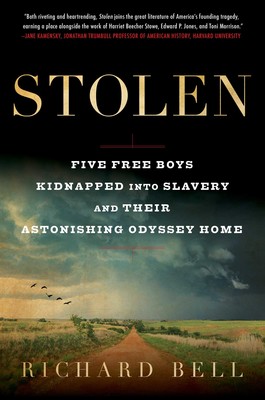Authors:
Historic Era: Era 5: Civil War and Reconstruction (1850-1877)
Historic Theme:
Subject:
Fall 2020 George Washington Prize | Volume 65, Issue 8


Authors:
Historic Era: Era 5: Civil War and Reconstruction (1850-1877)
Historic Theme:
Subject:
Fall 2020 George Washington Prize | Volume 65, Issue 8
Excerpted from the George Washington Book Prize finalist Stolen: Five Free Boys Kidnapped into Slavery and Their Astonishing Odyssey Home, by Richard Bell (37Ink).

Cornelius Sinclair was ten years old and he was trapped. He was stuck in the belly of a small ship bobbing in the middle of the Delaware River, a mile south of Philadelphia. A man had grabbed him from a spot near that city’s market an hour ago, shoved a black gag across his mouth, tossed him into a wagon, and hauled him here.
It was dark below the waterline, but Cornelius could see enough to know that he was not alone. Four pairs of eyes stared back at him—four other black boys.
Yesterday they had all been free. Today they were slaves, prisoners of a gang of child snatchers who planned to sell their lives and labor, most likely to plantation owners in the Deep South. If the boys’ abductors got away with this, Cornelius would spend the rest of his life as someone else’s property somewhere very far away. He would never see his family again.
Cornelius disappeared from Philadelphia in late August 1825, about nine months short of the fiftieth anniversary of the signing of the Declaration of Independence in that city in the summer of 1776. So much had changed since then. The new nation’s population had tripled, topping ten million, its land area had more than doubled, and the number of states in the union had jumped from thirteen to twenty-four, all of them now latticed together by ever-expanding networks of roads, canals, and steamboat routes.
Slavery in America was changing too. In 1776, there had been enslaved people in every rebel colony, but by 1825, slavery was dead or dying in the North. Fewer than twenty thousand black northerners remained in bondage, most of them in rural parts of New Jersey and New York where slavery was on its last legs. In the South, it was a different story. Slavery remained profitable and popular there, and more than 1.75 million black southerners lived as slaves. Assuming office in March 1825, John Quincy Adams, the sixth president of the United States, presided over a union equally divided between free states and slave states, twelve of them apiece.
The Mason-Dixon Line, which separated Pennsylvania—a free state —from Maryland and Delaware—two slave states—seemed to split the nation in two. It served, in the words of its recent biographer, as “the closest thing to a modern international border anywhere in North America.”
Situated just 40 miles north of that border, Philadelphia was one of the nearest free cities to the slave South. That proximity made its many free black residents attractive targets for professional